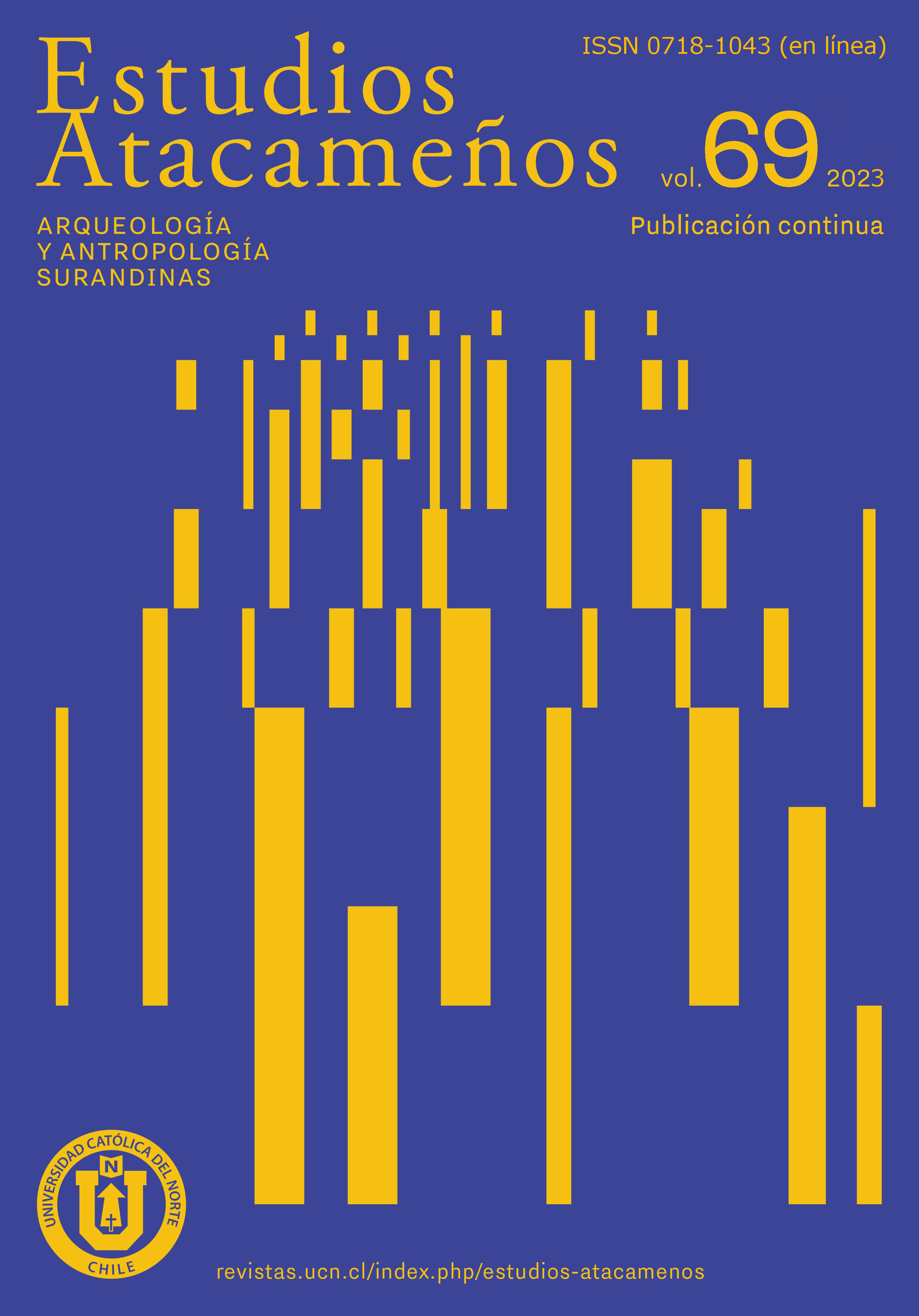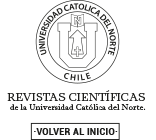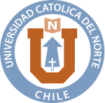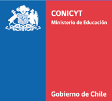Roles y legitimidad de los envarados
Hacendados, ruwales y relación con el Estado en comunidades Q’ero (Cusco, Perú, 1922- 2020)
DOI:
https://doi.org/10.22199/issn.0718-1043-2023-0021Palabras clave:
comunidad campesina, autoridades comunales, carnaval, hacienda, Estado, no-humanosResumen
Este articulo analiza los roles y la legitimidad de los envarados en la hacienda Q’ero (Paucartambo, Cusco) y en dos de las comunidades Q’ero que se formaron a partir de esta. A pesar que su relación con la hacienda y el estado se remonta al s XVII, las comunidades Q’ero tienden a ser presentadas como arquetipos de una autenticidad indígena prístina. Usando los registros etnográficos de empiezan en los 1920s y trabajo de campo, el articulo muestra cómo los envarados eran fundamentales en la organización del trabajo en la hacienda y su legitimidad externa provenía del hacendado y de autoridades estatales. Finalizada la hacienda, estas autoridades se articulan con aquellas de la Comunidad Campesina, institución a través de la cual el estado las reconoció en los 1980s. La antigua legitimidad de los envarados asociada al poder externo a la comunidad se torna en una interna muy débilmente asociada al estado. Las conversiones evangélicas y el análisis de las celebraciones a cargo de los envarados muestran cómo estos son cruciales en la recreación de una comunidad que incluye a los seres humanos y a los ruwales – lugares con nombre, agencia e intencionalidad propios – que constituyen el territorio comunal.
Citas
Allen, C. J. (1988). The hold life has: Coca and cultural identity in an Andean community. Smithsonian Institution Press.
Anrup, R. (1990). El taita y el toro: En torno a la configuración patriarcal del régimen hacendario cuzqueño. Universidad de Estocolmo.
Ansion, J., Diez, A. y Mujica, L. (2000). Acerca de las autoridades locales. En J. Ansion, A. Diez, y L. Mujica (Eds.), Autoridad en Espacios Locales. Una mirada desde la antropología (pp. 9–25). Fondo Editorial PUCP.
Canessa, A. (2020). Un carrusel de cosmologías: Giros ontológicos en el mundo andino. En O. Muñoz (Ed.), Andes. Ensayos de etnografía teórica (pp. 341–364). Nola.
Castillo, P. (2007). Las comunidades campesinas en el siglo XXI: Balance jurídico. En P. Castillo (Ed.), ¿Qué sabemos de las comunidades campesinas? (pp. 15–106). ALLPA, Comunidades y Desarrollo.
Challco, S. (1994). Composición y tenencia de tierras: Valle de Paucartambo-Cuzco: Ss. XVI-XVIII. Universidad Nacional Mayor de San Marcos, Seminario de Historia Rural Andina.
Cometti, G. (2015). Lorsque le brouillard a cessé de nous écouter. Changement climatique et migrations chez les Q’eros des Andes Péruviennes. Peter Lang.
Cotler, J. (1969). Actuales pautas de cambio en la sociedad rural del Perú. En J. Matos Mar, J. Cotler y L. Williams (Eds.), Dominación y cambios en el Perú rural (pp. 60–79). IEP.
CVR. (2003). Informe Final. Comisión de la Verdad y Reconciliación.
Damonte, G. (2000). Apuntes sobre el teniente gobernador. En J. Ansión, A. Diez y L. Mujica (Eds.), Autoridad en espacios locales. Una mirada desde a antropología (pp. 109–124). Fondo Editorial PUCP.
De la Cadena, M. (2000). Indigenous Mestizos: The politics of race and culture in Cuzco, Peru, 1919-1991. Duke University Press.
De la Cadena, M. (2010). Indigenous cosmopolitics in the Andes: Conceptual reflections beyond “Politics”. Cultural Anthropology, (25), 334–370. https://doi.org/10.1111/j.1548-1360.2010.01061.x
De la Cadena, M. (2015). Earth Beings: Ecologies of Practice across Andean Worlds. Duke University Press.
Diez, A. (1998). Comunes y haciendas: Procesos de comunalización en la Sierra de Piura (siglos XVIII al XX). CIPCA; CBC.
Diez, A. (2006). Las organizaciones colectivas, los recursos y los pueblos indígenas en el Perú. En F. Eguren (Ed.), Reforma Agraria y Desarrollo Rural en la Región Andina (pp. 111–129). CEPES.
Diez, A. (2007). Organización y poder en comunidades, rondas campesinas y municipios. En P. Castillo (Ed.), ¿Qué sabemos de las comunidades campesinas? (pp. 107–152). ALLPA, Comunidades y Desarrollo.
Diez, A. (2014). Autoridades locales y comunidades indígenas en el Perú del siglo XIX. Una aproximación general desde la sierra centro y norte del Perú. Boletín del Instituto Riva-Agüero, (304), 129–149.
Earls, J. (1991). Ecología y agronomía en los Andes. Hisbol.
Espinoza, J. M. e Iberico, R. (2021). Más en las obras que en las palabras: Historia de los centros sociales de la Compañía de Jesús en el Perú. Fondo Editorial PUCP, Universidad Antonio Ruiz de Montoya.
Flores Ochoa, J. A. (2005). ¿Por qué Q’ero? En J. A. Flores Ochoa y J. V. Núñez del Prado (Eds.), Q’ero, el último ayllu inka: Homenaje a Oscar Núñez del Prado y a la expedición científica de la UNSAAC a la nación Q’ero en 1955 (2a ed., pp. 29–36). Facultad de Ciencias Sociales UNMSM, INC Cusco.
Flores Ochoa, J. A. y Fries, A. M. (1989). Puna, qheswa, yunga: El hombre y su medio en Q’ero. Fondo Editorial del Banco Central de Reserva del Perú.
Flores Ochoa, J. A., Núñez del Prado, J. V., y Castillo Farfán, M. (1983). Q’ero, el último ayllu inka: Homenaje a Oscar Núñez del Prado Castro. Centro de Estudios Andinos Cusco.
Fuenzalida, F. (1970). La estructura de la comunidad de indígenas tradicional. Una hipótesis de trabajo. En J. Matos Mar (Ed.), Hacienda, Comunidad y Campesino en el Perú (pp. 219–263). Instituto de Estudios Peruanos.
Godelier, M. (1986). La producción de los grandes hombres. Poder y dominación masculina entre los Baruya de Nueva Guinea. Akal.
Goffman, E. (1986). Frame analysis: An essay on the organization of experience. Northeastern University Press.
Gose, P. (2008). Invaders as ancestors: On the intercultural making and unmaking of Spanish colonialism in the Andes. University of Toronto Press.
Gose, P. (2018). The semi-social mountain: Metapersonhood and political ontology in the Andes. HAU: Journal of Ethnographic Theory, 8(3), 488–505.https://doi.org/10.1086/701067
Gow, D. D. (1973). El impacto de la reforma agraria sobre el sistema de cargos. Allpanchis, (5), 131–158. https://doi.org/10.36901/allpanchis.v5i5.379
Gow, R. y Condori, B. (1976). Kay Pacha. CBC.
Guerrero, A. (1991). La semántica de la dominación: El concertaje de indios. Ediciones Libri Mundi.
Gutiérrez, R. (1984). Notas sobre las haciendas del Cusco. FECIC.
Hansen, P. (1993). Perspectivas Pastorales. En B. Schlegelberger (Ed.), La tierra vive. Religion agraria y cristianismo en los Andes centrales peruanos (pp. 266–286). CCAIJO.
INC-Cusco. (2006). Plan integral de etnodesarrollo para las comunidades de la Nación Q´ero (parte alta) – Paucartambo (2006–2015). Instituto Nacional de Cultura. Dirección Regional de Cultura Cusco.
Isbell, B. J. (1978). To defend ourselves: Ecology and ritual in an Andean village. University of Texas Press.
Kapsoli, W. (1987). Los movimientos campesinos en el Perú (3ra ed.). Ediciones Atusparia.
LeBorgne, Y. (2005). Evolución del indigenismo en la sociedad peruana. El tratamiento al grupo étnico Q’ero. En A. Molinié (Ed.), Etnografías de Cuzco. CBC, IFEA.
Leinaweaver, J. B. (2008). The circulation of children: Kinship, adoption, and morality in Andean Peru. Duke University Press.
Magallanes, C. (2014). Autoridades Políticas Locales en el Perú: Gobernador y Teniente Gobernador. Congreso de la República, Departamento de Investigación y Documentación Parlamentaria.
Mannheim, B. (2020). Southern Quechua Ontology. En S. Kosiba, J. W. Janusek y T. B. F. Cummins (Eds.), Sacred Matter: Animacy and Authority in the Americas (pp. 371–398). Harvard University Press for Dumbarton Oaks.
Mannheim, B. y Salas Carreño, G. (2015). Wak’a: Entifications of the Andean Sacred. En T. Bray (Ed.), The Archaeology of W’akas: Explorations of the Sacred in the pre-Columbian Andes (pp. 47–72). University of Colorado Press.
Mayer, E. (2004). Las reglas de juego en la reciprocidad andina. En Casa, chacra y dinero: Economías domésticas y ecología en los Andes (pp. 128–166). Instituto de Estudios Peruanos.
Morote, E. (2005). Un nuevo mito de fundación del imperio. En J. A. Flores Ochoa y J. V. Núñez del Prado (Eds.), Q’ero, el último ayllu inka: Homenaje a Oscar Núñez del Prado y a la expedición científica de la UNSAAC a la nación Q’ero en 1955 (2a ed.,pp. 287–310). Facultad de Ciencias Sociales UNMSM, INC Cusco.
Núñez del Prado, O. (1957). El hombre y la familia: Su matrimonio y organizacion politico-social en Q’ero. Revista Universitaria, 114, 9–31.
O’Phelan, S. (1997). Kurakas sin sucesiones: Del cacique al alcalde de Indios (Perú y Bolivia, 1750-1835). CBC.
Orlove, B. S., Godoy, R. y Morlon, P. (1996). Sistemas de barbecho sectorial. En P. Morlon (Ed.), Comprender la agricultura campesina en los andes centrales (pp. 86–118). CBC, IFEA.
Ossio, J. M. (2005). Los Q’ero de Cusco. En J. A. Flores Ochoa y J. V. Núñez del Prado (Eds.), Q’ero, el último ayllu inka: Homenaje a Oscar Núñez del Prado y a la expedición científica de la UNSAAC a la nación Q’ero en 1955 (2a ed., pp. 245–264). Facultad de Ciencias Sociales UNMSM, INC Cusco.
Paulson, S. (2006). Body, nation, and consubstantiation in Bolivian ritual meals. American Ethnologist, (33), 650–664.
Pérez Galán, B. (2004). Somos como Incas: Autoridades tradicionales en los Andes peruanos, Cuzco. Iberoamericana ; Vervuert.
Poole, D. (1988). Landscapes of power in a cattle-rustling culture of southern Andean Peru. Dialectical anthropology, (12), 367–398.
Rama, A. (1984). La ciudad letrada. Ediciones del Norte.
Rasnake, R. N. (1988). Domination and cultural resistance: Authority and power among an Andean people. Duke University Press.
Salas Carreño, G. (2012). Negotiating Evangelicalism and New Age tourism through Quechua ontologies in Cuzco, Peru [Doctoral dissertation, University of Michigan]. Repositorio Institucional-University of Michigan.
Salas Carreño, G. (2016). Places are Kin: Food, Cohabitation, and Sociality in the Southern Peruvian Andes. Anthropological Quarterly, 89(3), 813–840. https://doi.org/10.1353/anq.2016.0048
Salas Carreño, G. (2019). Lugares Parientes. Comida, cohabitación y mundos andinos. Fondo Editorial PUCP.
Salas Carreño, G. (2020). Indexicality and the Indigenization of Politics: Dancer–Pilgrims Protesting Mining Concessions in the Andes. The Journal of Latin American and Caribbean Anthropology, 25(1), 7–27. https://doi.org/10.1111/jlca.12462
Schlegelberger, B. (1993). La tierra vive. Religión agraria y cristianismo en los Andes centrales peruanos. CCAIJO.
Silverman, G. P. (1998). El tejido andino: Un libro de sabiduría. Fondo de Cultura Económica.
Stern, S. J. (Ed.). (1987). Resistance, Rebellion, and Consciousness in the Andean Peasant World—18th to 20th Centuries. University of Wisconsin Press.
Stern, S. J. (1993). Peru’s Indian peoples and the challenge of Spanish conquest: Huamanga to 1640. University of Wisconsin Press.
Thomson, S. (2002). We alone will rule: Native Andean politics in the age of insurgency. University of Wisconsin Press.
Thurner, M. (1997). From Two Republics to One Divided: Contradictions of Postcolonial Nationmaking in Andean Peru. Duke University Press.
Van Vleet, K. E. (2008). Performing kinship: Narrative, gender, and the intimacies of power in the Andes. University of Texas Press.
Webster, S. S. (1972). The social organization of a native Andean community [Doctoral dissertation, University of Washington]. Repositorio Institucional-University of Washington.
Weismantel, M. (1995). Making Kin: Kinship Theory and Zumbagua Adoptions. American Ethnologist, (22), 685–704.
Wissler, H. (2009). From grief and joy we sing: Social and cosmic regenerative processes in the songs of Q’eros, Peru [Doctoral dissertation, Florida State University]. Repositorio Institucional-Florida State University.
Wolf, E. R. (1972). Los campesinos. Universidad Nacional San Cristóbal de Huamanga.
Yábar Palacios, L. (1922). El Ayllu de Qqueros (Paucartambo). Revista Universitaria, (38), 3–26.
Publicado
Cómo citar
Número
Sección
Derechos de autor 2023 Guillermo Salas

Esta obra está bajo una licencia internacional Creative Commons Atribución 4.0.

Todos los trabajos publicados en Revista Estudios Atacameños (eISSN:0718-1043) están sujetos a una licencia Creative Commons Reconocimiento 4.0 Internacional
Los autores continúan como propietarios de sus trabajos, y pueden volver a publicar sus artículos en otro medio sin tener que solicitar autorización, siempre y cuando indiquen que el trabajo fue publicado originariamente en Revista Estudios Atacameños (eISSN:0718-1043).

















